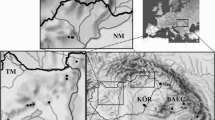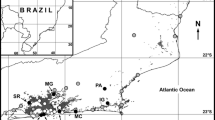Abstract
Genetic drift tends to lower geneticvariability in peripheral and isolatedpopulations. These populations also tend todiverge from more central populations if thedegree of isolation is high enough. Theseprocesses could have opposite effects on thevalue of the respective populations in thespecies conservation context. On the basis ofallozyme polymorphism data, we compare geneticvariability and differentiation between core,peripheral and isolated populations of thescarce heath, a butterfly endangered inNorthern and Central Europe. Genetic variationwas lowest in populations that were bothperipheral and isolated(P = 16.5%, Hobs = 0.017),and highest in the central populations(P = 35%,Hobs = 0.052). However, overall variability waslow also in the core area compared to that ofclosely related butterfly species. Theperipheral region was more differentiated fromthe other regions than the isolated region(FPC = 0.118, FPI = 0.257,FIC = 0.068). This study indicated thatisolation in combination with marginality havecaused an erosion of the gene pool. Theobserved patterns may be caused both by thecontemporary population structure of thespecies, as well as by the colonisationhistory. Both genetic and ecological evidencesuggests that the species is likely to followthe stepping-stone model of dispersal.
Similar content being viewed by others
References
Allendorf FW, Leary RF (1986) Heterozygosity and fitness in natural populations of animals. In: Conservation Biology. The Science of Scarcity and Diversity (ed. Soulé ME), pp. 57–76.Sinauer associates, Inc., Sunderland, Massachusetts.
Avise JC (1994) Speciation and hybridization. In: Molecular Markers, Natural History and Evolution, pp. 252–305. Chapman and Hall, New York.
Berglind S-Å (1996) Coenonympha hero Linné 1761, Scarce Heath. Species Fact Sheet. Threatened Species Unit, Uppsala (In Swedish).
Bossart JL, Scriber JM (1995) Maintenance of ecologically significant genetic variation in the Tiger Swallowtail butterfly through differential selection and gene flow. Evolution, 49(6), 1163–1171.
Brookes MI, Graneau YA, King P, Rose OC, Thomas CD, Mallet JLB (1997) Genetic analysis of founder bottlenecks in the rare British butterfly Plebejus argus. Cons. Biol., 11, 648–661.
Cassel A, Windig J, Nylin S, Wiklund C (2001) Effects of population size and food stress on fitness-related characters in the scarce heath, a rare butterfly in Western Europe. Conserv. Biol., 15, 1667–1673.
Felsenstein J (1989) PHYLIP; phylogeny inference package (version 3.2). Cladistics, 5, 164–166.
Goudet J (1995) FSTAT version 1.2: A computer program to calculate F-statistics. J. Hered., 86, 485–486.
Gärdenfors U (ed.) (2000) The 2000 Redlist of Swedish species. Uppsala (In Swedish).
Hartl DL, Clark AG (1997) Random genetic drift. In: Principles of Population Genetics. 3rd edition, pp. 267–312. Sinauer associates, Inc. Sunderland, Massachusetts.
Hedrick PW (1994) Purging inbreeding depression and the probability of extinction: Full-sib mating. Heredity, 73, 363–372.
Hewitt GM(1996) Some genetic consequences of ice ages, and their role in divergence and speciation. Biol. J. Linn. Soc., 58, 247–276.
Hewitt GM (1999) Post-glacial re-colonization of European biota. Biol. J. Linn. Soc., 68, 87–112.
Hindar K, Aagaard K, Balstad T, Hanssen O (1997) Genetisk variasjon og levedyktighet hos sommerfugler. Scientific report to The Research Council of Norway.
Ibrahim KM, Nichols RA, Hewitt GM (1996) Spatial patterns of genetic variation generated by different forms of dispersal during range expansion. Heredity, 77, 282–291.
Johannesen J, Veith M, Seitz A (1996) Population genetic structure of the butterfly Melitaea didyma (Nymphalidae) along a northern distribution range border. Mol. Ecol., 5, 259–267.
Karhu A, Hurme P, Karjalainen M, Karvonen P, Kärkkäinen K, Neale D, Savolainen O (1996) Do molecular markers reflect patterns of differentiation in adaptive traits of conifers? TAG, 93, 215–221.
Kesküla T (1992) Distribution Maps of Estonian Butterflies (Lepidoptera: Hesperoidea, Papilionidea). Acta musei zoologici universitatis Tartuensis No 6.
Keyghobadi N, Roland J, Strobeck C (1999) Influence of landscape on the population genetic structure of the alpine butterfly Parnassius smintheus (Papilionidae). Mol. Ecol., 8, 1481–1495.
Korshunov YP, Gorbunov PY (1995) Butterflies of the Asian Part of Russia: A Handbook — Yekaterinburg, 202 pp. The Ural University publishers (In Russian).
Lande R, Barrowclough GF (1987) Effective population size, genetic variation and their use in population management. In: Viable Populations for Conservation (ed. ME Soulé), pp. 87–123. Cambridge University Press, Cambridge.
Lesica P, Allendorf FW (1995) When are peripheral populations valuable for conservation? Conserv. Biol., 9, 753–760.
Malacrida AR, Marinoni F, Torti C, Gomulski LM, Sebastiani F, Bonvicini C, Gasperi G, Guglielmino CR (1998) Genetic aspects of the worldwide colonization process of Ceratitis capitata. J. Hered., 9, 501–507.
Marttila O, Haahtela T, Aarnio H, Ojalainen P (1990) Suomen perhoset. Päiväperhoset [Butterflies of Finland], 362 pp. Kirjayhtymä OY.
Motro U, Thomson G (1982) On heterozygosity and the effective size of populations subject to size changes. Evolution, 36, 1059–1066.
Murphy RW, Sites JW jr, Buth DG, Haufler CH (1990) Proteins I: Isozyme electrophoresis. In: Molecular systematics (eds. Hillis DM, Moritz C), pp. 45–126. Sinauer Assoc., Sunderland.
Nakanishi M, Wilson AC, Nolam RA, Gorman GC, Bailey GS (1969) Phenoxyethanol: Protein preservation for taxonomists. Science, 169, 681–683.
Nei M (1978) Estimation of average heterozygosity and genetic distance from small number of individuals. Genetics, 83, 583–590.
Nei M, Maruyama T, Chakraborty R (1975) The bottleneck effect and genetic variability in populations. Evolution, 29, 1–10.
Pasteur N, Pasteur G, Bonhomme F, Catalan J, Britton-Davidian J. (1988) Practical Isozyme Genetics. Ellis Horwood Ltd., Chichester.
Pamilo P, Savolainen O (1999) Post-glacial colonization, drift, local selection and conservation value of populations: A northern perspective. Hereditas, 130, 229–238.
Porter AH, Geiger H (1988) Genetic and phenotypic structure of the Coenonympha tullia complex (Lepidoptera: Nympalidae: Satyrinae) in California: No evidence for species boundaries. Can. J. Zool., 66, 2751–2765.
Porter AH, Schneider RW, Price BA (1995) Wing pattern and allozyme relationships in the Coenonympha arcania group, emphasising the C. gardetta-darwiniana contact area at Bellwald, Switzerland (Lepidoptera, Satyridae). Nota lepid., 17, 155–174.
Raymond M, Rousset F (1995) GENEPOP (version 1.2): Population genetics software for exact tests and ecumenicism. J. Heredity, 86, 248–249.
Rohlf FJ (1998) NTSYS-pc: Numerical Taxonomy and Multivariate Analysis System. Exeter Publishing Ltd., New York.
Schmitt T, Seitz A (2001) Allozyme variation in Polyommatus coridon (Lepidoptera: Lycaenidae): Identification of ice-age refugia and reconstruction of post-glacial expansion. J. Biography, 28, 1–8.
Schmitt T, Varga Z, Seitz A (2000) Forests as dispersal barriers for Erebia medusa (Nymphalidae, Lepidoptera). Basic Appl. Ecol., 1, 53–59.
Sjögren P (1991) Genetic variation in relation to demography of peripheral pool frog populations (Rana lessonae). Evol.Ecol., 5, 248–271.
Sjögren-Gulve P, Berg LM (1999) Allozyme variation as a demographic predictor at high altitudes: The moor frog and the pool frog at 60°N. Hereditas, 130, 317–323.
Sokal RR, Rohlf FJ (1998) Biometry. The principles and practice of statistics in biological research, 3rd edition, 813-819 pp. W.H. Freeman and company, New York.
Stone GN, Sunnucks P (1993) Genetic consequences of an invasion through a patchy environment — the cynipid gallwasp Andricus quercuscalicis (Hymenoptera: Cynipidae). Mol. Ecol., 2, 251–268.
Swedish National Atlas (1992) Jordbruket. Lantmäteriet / Kartcentrum. Stockholm (In swedish).
Swofford DL, Selander RB (1997) BIOSYS-2 A Computer Program for the Analysis of Allelic Variation in Genetics. University of Illinois at Urbana-Champaign Urbana, Illinois, USA.
Tregenza T, Butlin RK (1999) Genetic diversity: Do marker genes tell us the whole story? In: Evolution of Biological Diversity (eds. Magurran AE, May RM), pp. 37–55. Oxford University Press, Oxford.
Vandewoestijne S, Nève G, Baguette M (1999) Spatial and temporal population genetic structure of the butterfly Aglais urticae L. (Lepidoptera, Nymphalidae). Mol. Ecol., 8, 1539–1543.
van Swaay C, Warren M (1999) Red Data Book of European Butterflies (Rhopalocera), 264 pp. Nature and environment, No. 99. Council of Europe Publishing, Strasbourg.
Vasari Y (1986) The Holocene development of the Nordic landscape. In: Nordic Late Quaternary Biology and Ecology (ed. Königsson L-K), Strie, 24, 15–19. Uppsala.
Voelker RA, Schaffer HE, Mukai T (1980) Spontaneous allozyme mutations in Drosophila melanogaster: Rate of occurrence and nature of the mutants. Genetics, 94, 961–968.
Weir BS, Cockerham CC (1984) Estimating F-statistics for the analysis of population structure. Evolution, 38, 1358–1370.
Wiemers M (1994) Differenzierungsmuster bei Artbildungsprozessen: Morphologisch-biometrische und enzymelektrophoretische Untersuchungen am Coenonympha arcania (Linnaeus, 1761) — Superspezies-Komplex (Lepidoptera: Nymphalidae: Satyrinae). — Diplomarbeit Univ. Bonn. 158 + 21 pp. and 8 plates (6 col.).
Wiemers M (1998) Coenonympha darwiniana — a hybrid taxon? New insights through allozyme electrophoresis (Lepidoptera, Nymphalidae, Satyrinae). Mem. Soc. R. belge Ent., 38, 41–69.
Wiernasz DC (1989) Ecological and genetic correlates of range expansion in Coenonympha tullia. Biol. J. Linn. Soc., 38, 197–214.
Wright S (1977) Evolution and the Genetics of Populations, vol. 3, 44–96 pp. Experimental results and evolutionary deductions. University of Chicago Press, Chicago.
Wright S (1978) Evolution and the Genetics of Populations, vol. 4. Variability Within and Among Natural Populations. University of Chicago Press, Chicago.
Author information
Authors and Affiliations
Rights and permissions
About this article
Cite this article
Cassel, A., Tammaru, T. Allozyme variability in central, peripheral and isolated populations of the scarce heath (Coenonympha hero: Lepidoptera, Nymphalidae); implications for conservation. Conservation Genetics 4, 83–93 (2003). https://doi.org/10.1023/A:1021884832122
Issue Date:
DOI: https://doi.org/10.1023/A:1021884832122




